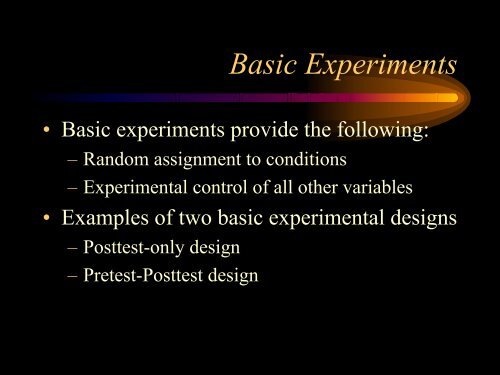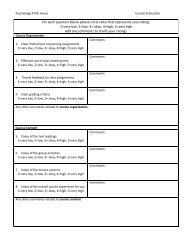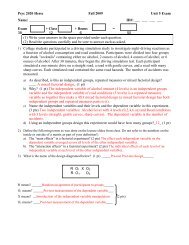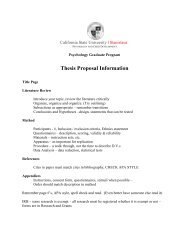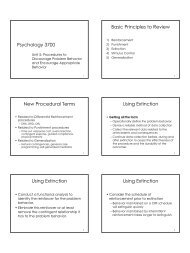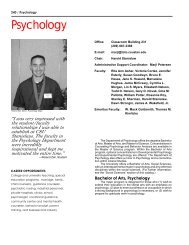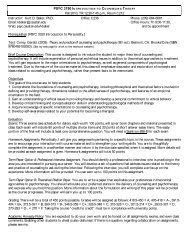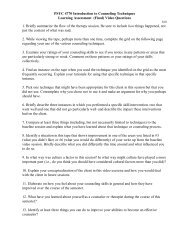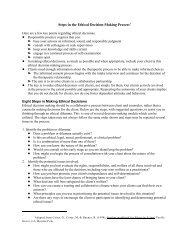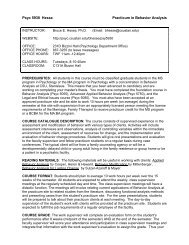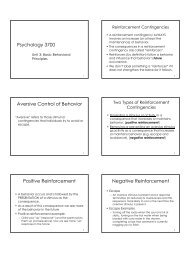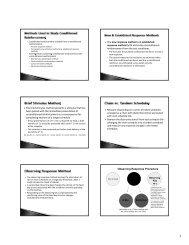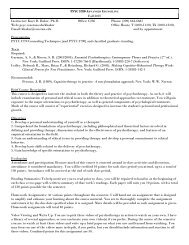Basic Experiments - Psychology and Child Development
Basic Experiments - Psychology and Child Development
Basic Experiments - Psychology and Child Development
You also want an ePaper? Increase the reach of your titles
YUMPU automatically turns print PDFs into web optimized ePapers that Google loves.
<strong>Basic</strong> <strong>Experiments</strong>• <strong>Basic</strong> experiments provide the following:– R<strong>and</strong>om assignment to conditions– Experimental control of all other variables• Examples of two basic experimental designs– Posttest-only design– Pretest-Posttest design
Posttest-only DesignR X OR O• All participants are r<strong>and</strong>omly assigned to one oftwo groups. (R indicates r<strong>and</strong>om assignment)• One groups gets the independent variable (X) thecontrol group does not.• Any difference in the dependent variable (O)should be due to the effect of the independentvariable.
Pretest-Posttest DesignR O 1 X O 2R O 1 O 2• Participants are r<strong>and</strong>omly assigned (R) to one oftwo groups <strong>and</strong> each group is given a pretest (O 1 ).• One group is administered the IV (X) <strong>and</strong> thecontrol group is not.• Both groups are given the posttest (O 2 ).• Any differences from pre to posttest are attributedto the independent variable (X)
Experimental Design Practice• A researcher was interested in studying the effecttaking a course in child development had on the waysparents h<strong>and</strong>le particular childrearing issues. Shedecided to show the participants 4 short videos ofchildren doing particular things (two discipline related<strong>and</strong> two related to teaching a new skill) <strong>and</strong> then havethem describe what they would do as a parent in eachsituation.– Operationally define the independent <strong>and</strong> dependentvariables in terms of how you will measure each.– Design a posttest-only experiment– Design a pretest-posttest experiment
Advantages• Pretests allow the experimenter to assess thesimilarity of the two groups.• Pretests are sometimes necessary to selectparticipants that meet the requirements of theresearch question.• Pretests allow the experimenter to assess theeffects of mortality (participants dropping out ofthe study before is ends) on the posttest results.
Disadvantages• Pretests may time consuming <strong>and</strong> awkwardto administer.• Pretests may sensitize the participants towhat is being studied <strong>and</strong> influence whatthey do during the experiment.
Your <strong>Child</strong>rearing ExperimentExample• Relate the advantages <strong>and</strong> disadvantages ofpretests to your two experiments.• Which design do you think is better for thequestion the researcher wants to answerabout the effectiveness of a childdevelopment class on childrearingpractices? Why?
Solomon Four-Group DesignControlR O 2ExperimentalR X O 2R O 1 O 2R O 1 X O 2• Participants are r<strong>and</strong>omly assigned (R) to one of fourgroups• Two groups are given Pre & Post-test <strong>and</strong> two groups aregiven only the Post-test.• The IV (X) is given to a Pre/Post-test group <strong>and</strong> a Post-testonly group, the other two groups are control groups.• Any differences between the two control groups or the twoexperimental groups is attributed to the Pre-test.


